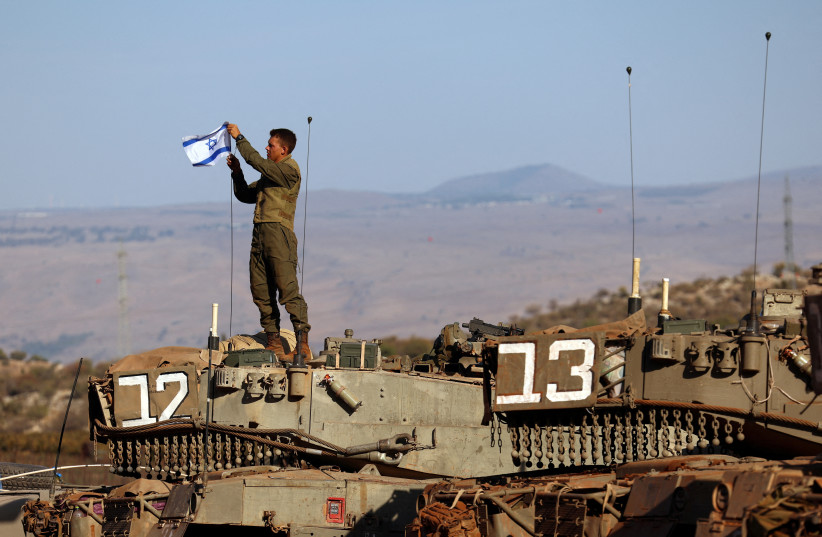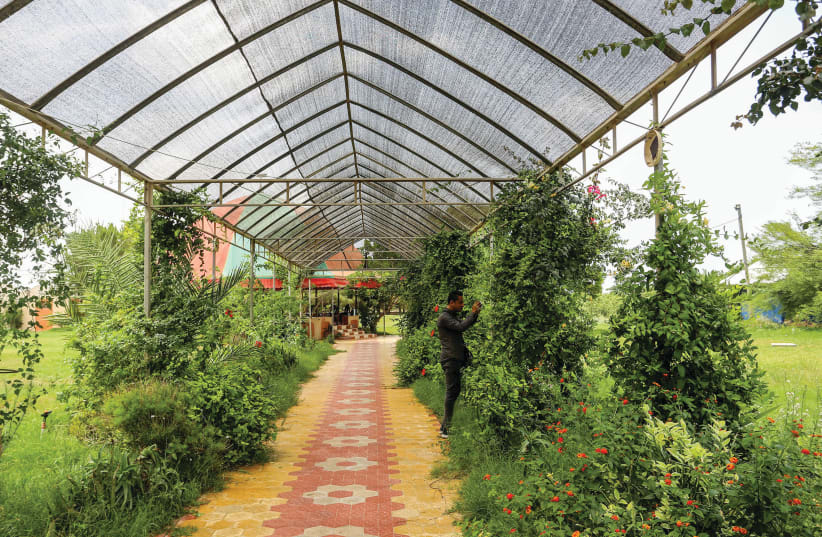This past Shabbat, the Israeli flag was raised over Gaza.
In a moving video clip circulating on social media, two Israeli soldiers standing atop a building hoisted the blue-and-white banner, signifying the Jewish state’s return to the strip of land along the Mediterranean Sea.
To mark the occasion, someone off camera noted that three weeks had passed since the Hamas invasion and massacre of 1,400 Jews and that “soldiers of the 52nd Battalion of the 401st Brigade are raising the flag of Israel in the heart of Gaza on the beach. We will not forget, we will not forgive, and we will not stop until victory.”
It was a powerful scene, one that embodied Israel’s resilient spirit and determination, and its ability to bounce back from even the most painful of disasters.
Indeed, despite the traumatic blow inflicted by Hamas terrorists, the long arm of Jewish justice is now at work, as the IDF ground operation in Gaza has entered its next phase.

Thus far, the government has highlighted two primary objectives in Israel’s war: toppling the Hamas regime; and the return of the 240 hostages held captive.
But in addition to these two sacred goals, I would like to suggest a third aim that we should strive to achieve once the fighting is complete: Let’s rebuild the Jewish communities of Gush Katif that were uprooted 18 years ago and restore a civilian Jewish presence in Gaza.
Rebuilding Gush Katif and restoring a Jewish presence to the Gaza Strip
After all, in August 2005 we were assured by then-prime minister Ariel Sharon, and much of the mainstream media, that Israel’s pullout would strengthen Palestinian moderates, weaken Islamic extremists, and silence the world’s criticism.
As a result, over 9,000 Jews in 25 communities throughout Gaza were summarily torn away from their homes and exiled.
Those who opposed the withdrawal, myself included, were derided as pessimists and naysayers, short-sighted, and worse.
But as the events of October 7 made clear, the lack of an Israeli presence in Gaza undermined our deterrent posture and intelligence-gathering capability and allowed Hamas to plan and train virtually at will.
If nothing else, it is a telling reminder of a basic and fundamental truth of Zionist history and Middle Eastern reality: Jewish settlements are not an obstacle to peace but an impediment to war.
Only by firmly planting the flag deep into every part of the Land of Israel can we ensure our continued existence in the face of ongoing Arab expansionism and Palestinian irredentism.
That is why, once the war is over, Israel should right the moral and historical wrong of Sharon’s disengagement plan and rebuild Gush Katif.
Our enemies’ strategic vision assumes that the Jewish presence in this part of the world is temporary or transitory. Hence, to best combat it, we must do everything in our power to demonstrate that it is wrong; we are here to stay.
SUCH AN approach is not new and has its roots in the classical Zionist response to the Arab unrest of 1936.
After Arab rioters attacked Jaffa and killed 16 Jews on April 19, 1936, the Arab High Command launched a general strike and pressed the British Mandate authorities to take steps to restrict the growth of the Jewish presence in the Land of Israel.
Zionist leaders David Ben-Gurion and Chaim Weizmann wisely rejected any attempt to limit Jewish immigration or land reclamation. They realized that such a stance would amount to appeasement, which would only fuel further Arab aggression against the Yishuv.
In his memoirs, Ben-Gurion wrote that “the Yishuv defended itself with courage, wisdom, and restraint... Not one Jewish settlement was abandoned; instead, new ones were established.”
Rather than yielding to Arab threats and violence, Ben-Gurion and the Zionist leadership pressed forward. In the face of those who sought to reduce the Jewish population, they responded by intensifying efforts to enlarge it as much as possible.
That must be our approach as well.
By reviving Gazan Jewish communities such as Dugit, Netzarim, Kfar Darom, and Neveh Dekalim, Israel can rewrite the reality on the ground and send a message to the Palestinians that they won’t soon forget.
To put it simply: The more you try to kill us, the more we will rebuild.
Sure, such a move will not be popular in the halls of the United Nations nor among the members of the European Parliament, but nothing Israel does ever really is.
Resurrecting Gush Katif is not only a moral imperative but a strategic one as well. It will strengthen our resolve as a nation and send a powerful and lasting message to our foes that the days of Israeli retreat and withdrawal are over.
Gaza is where the Palestinians created a culture of death and darkness. So let us rebuild it with Jewish life and light, and transform ruins to rebirth.
For that, in a nutshell, has been the story of our people down through the ages.
The writer served as deputy communications director under Prime Minister Benjamin Netanyahu during his first term of office.
